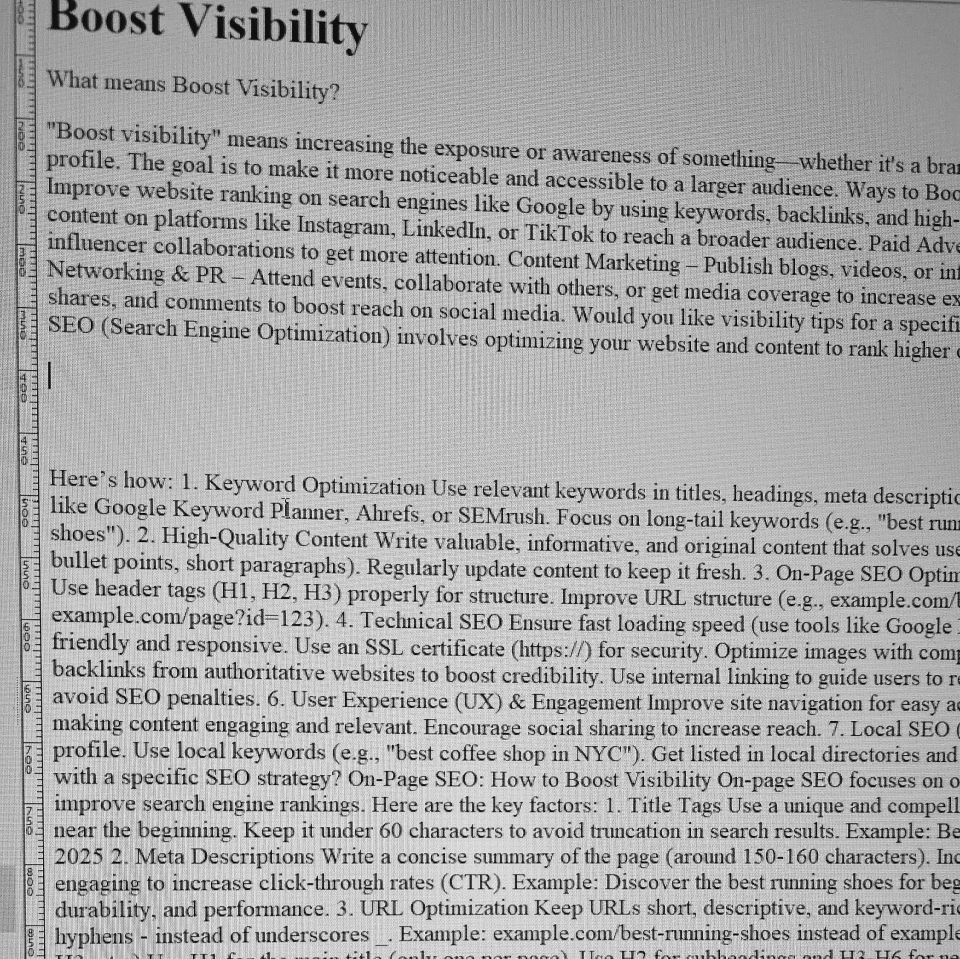
Public - Pixel
Public - Pixel | connect with customer Even if your online presence is solely for providing information, generating leads, or showcasing your business to potential future partners, the real challenge today isn’t finding a needle in a haystack—it’s finding the right needle in a stack of needles. We’re not talking about SEO (Search Engine Optimization). Opportunities to perfectly showcase what the customer is looking for — which, by the way, is exactly what search engines like Google aim to do—are just the beginning. We offer much more. While search engines like Google aim to provide a vast number of search results, our goal is to connect You directly with the people who are genuinely interested in Your products. The right customers should find you. Public-Pixel is a leader in evaluating processes to strategically enhance your online presence—without altering or manipulating your existing website. In fact, we don’t need access to your website at all. All we require is the product you want to promote, your target customer specifications, and the website where you want the traffic to be directed. |
|
Copyright © 2003-2025 PUBLIC-PIXEL |
"Boost visibility" means increasing the exposure or awareness of something—whether it's a brand, product, website, social media post, or personal profile. The goal is to make it more noticeable and accessible to a larger audience. Ways to Boost Visibility: SEO (Search Engine Optimization) – Improve website ranking on search engines like Google by using keywords, backlinks, and high-quality content. Social Media Marketing – Share content on platforms like Instagram, LinkedIn, or TikTok to reach a broader audience. Paid Advertising – Use Google Ads, Facebook Ads, or influencer collaborations to get more attention. Content Marketing – Publish blogs, videos, or infographics to attract and engage people.

Networking & PR – Attend events, collaborate with others, or get media coverage to increase exposure. Engagement Strategies – Encourage likes, shares, and comments to boost reach on social media. Would you like visibility tips for a specific platform or business?Boosting visibility through SEO (Search Engine Optimization) involves optimizing your website and content to rank higher on search engines like Google. Here’s how: 1. Keyword Optimization Use relevant keywords in titles, headings, meta descriptions, and content. Research keywords with tools like Google Keyword Planner, Ahrefs, or SEMrush. Focus on long-tail keywords (e.g., "best running shoes for beginners" instead of "running shoes"). 2. High-Quality Content Write valuable, informative, and original content that solves users’ problems. Use structured formatting (headings, bullet points, short paragraphs). Regularly update content to keep it fresh. 3. On-Page SEO Optimize meta titles and descriptions with keywords. Use header tags (H1, H2, H3) properly for structure. Improve URL structure (e.g., example.com/best-seo-tips instead of example.com/page?id=123). 4. Technical SEO Ensure fast loading speed (use tools like Google PageSpeed Insights). Make your site mobile-friendly and responsive. Use an SSL certificate (https://) for security. Optimize images with compressed file sizes and alt text. 5. Link Building Get backlinks from authoritative websites to boost credibility. Use internal linking to guide users to related content on your site. Fix broken links to avoid SEO penalties. 6. User Experience (UX) & Engagement Improve site navigation for easy access to information. Reduce bounce rate by making content engaging and relevant. Encourage social sharing to increase reach. 7. Local SEO (If Relevant) Optimize your Google My Business profile. Use local keywords (e.g., "best coffee shop in NYC"). Get listed in local directories and encourage customer reviews. Would you like help with a specific SEO strategy? On-Page SEO: How to Boost Visibility On-page SEO focuses on optimizing elements within your website to improve search engine rankings. Here are the key factors: 1. Title Tags Use a unique and compelling title for each page. Include primary keywords near the beginning. Keep it under 60 characters to avoid truncation in search results. Example: Best Running Shoes for Beginners | Ultimate Guide 2025 2. Meta Descriptions Write a concise summary of the page (around 150-160 characters). Include your target keyword naturally. Make it engaging to increase click-through rates (CTR). Example: Discover the best running shoes for beginners in 2025. Find the perfect fit for comfort, durability, and performance. 3. URL Optimization Keep URLs short, descriptive, and keyword-rich. Avoid unnecessary numbers or symbols. Use hyphens - instead of underscores _.
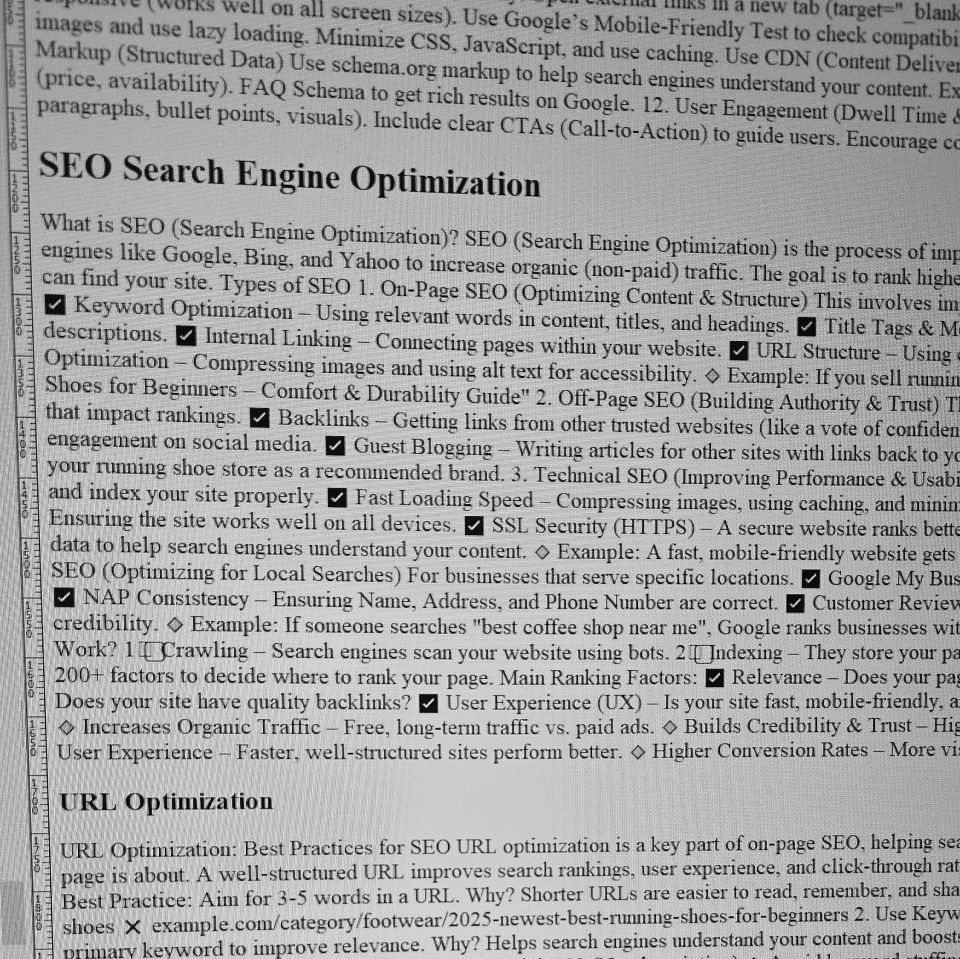
Example: example.com/best-running-shoes instead of example.com/page?id=12345 4. Header Tags (H1, H2, H3, etc.) Use H1 for the main title (only one per page). Use H2 for subheadings and H3-H6 for nested topics. Include keywords naturally in headers. Example: H1: Best Running Shoes for Beginners H2: How to Choose the Right Running Shoes H3: Factors to Consider (Cushioning, Fit, etc.) 5. Keyword Optimization Use primary keywords in the title, meta description, first 100 words, and headers. Avoid keyword stuffing (forcefully repeating words). Use LSI (Latent Semantic Indexing) keywords—related words that help search engines understand the content.
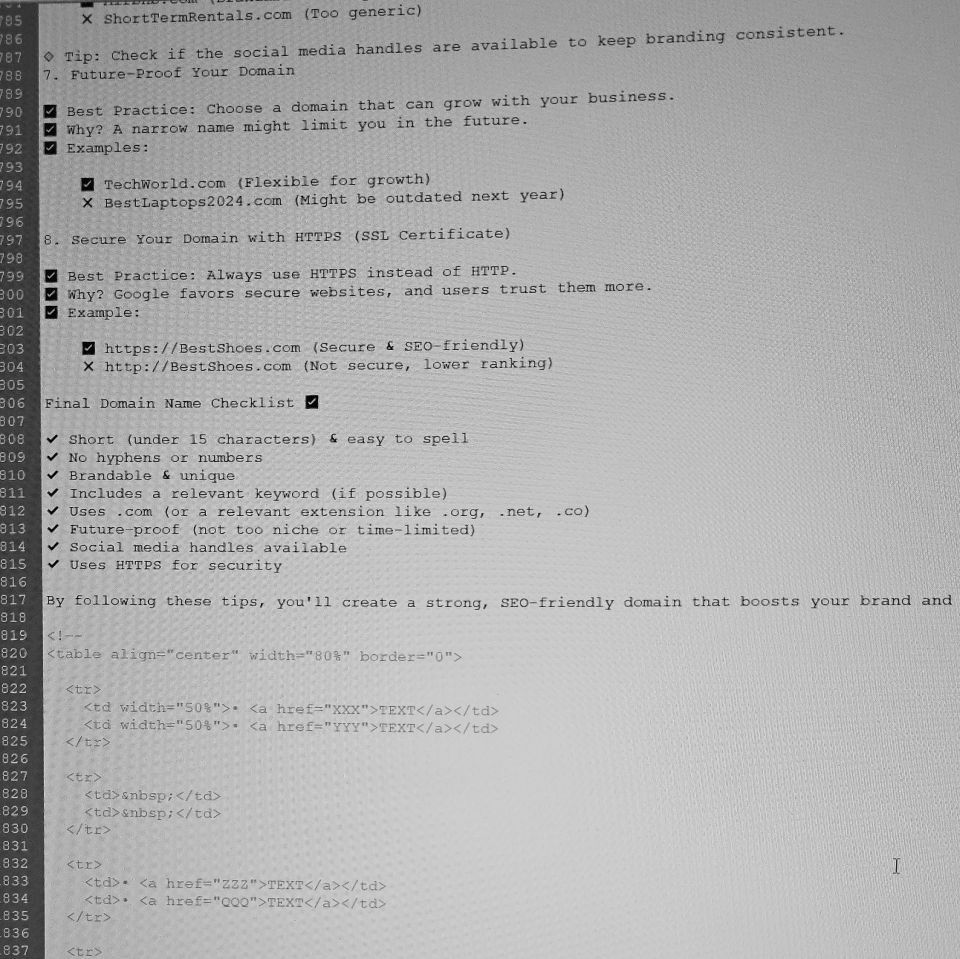
6. Image Optimization Use descriptive file names (e.g., best-running-shoes.jpg instead of IMG1234.jpg). Add alt text for better accessibility and SEO. Compress images for faster loading speed (use tools like TinyPNG). 7. Internal Linking Link to related pages on your site to improve navigation and SEO. Use descriptive anchor text instead of "click here." Example: Check out our running shoe buying guide for more tips. 8. External Linking Link to authoritative sources to improve credibility. Open external links in a new tab (target="_blank"). 9. Mobile-Friendliness Ensure your site is responsive (works well on all screen sizes). Use Google’s Mobile-Friendly Test to check compatibility. 10. Page Speed Optimization Optimize images and use lazy loading.

Minimize CSS, JavaScript, and use caching. Use CDN (Content Delivery Networks) to speed up loading. 11. Schema Markup (Structured Data) Use schema.org markup to help search engines understand your content. Examples: Product Schema for eCommerce (price, availability). FAQ Schema to get rich results on Google. 12. User Engagement (Dwell Time & Bounce Rate) Improve readability (short paragraphs, bullet points, visuals). Include clear CTAs (Call-to-Action) to guide users. Encourage comments and shares to increase engagement.
What is SEO (Search Engine Optimization)? SEO (Search Engine Optimization) is the process of improving a website’s visibility on search engines like Google, Bing, and Yahoo to increase organic (non-paid) traffic. The goal is to rank higher for relevant search queries so more people can find your site. Types of SEO 1. On-Page SEO (Optimizing Content & Structure) This involves improving individual web pages to rank higher. ✅ Keyword Optimization – Using relevant words in content, titles, and headings. ✅
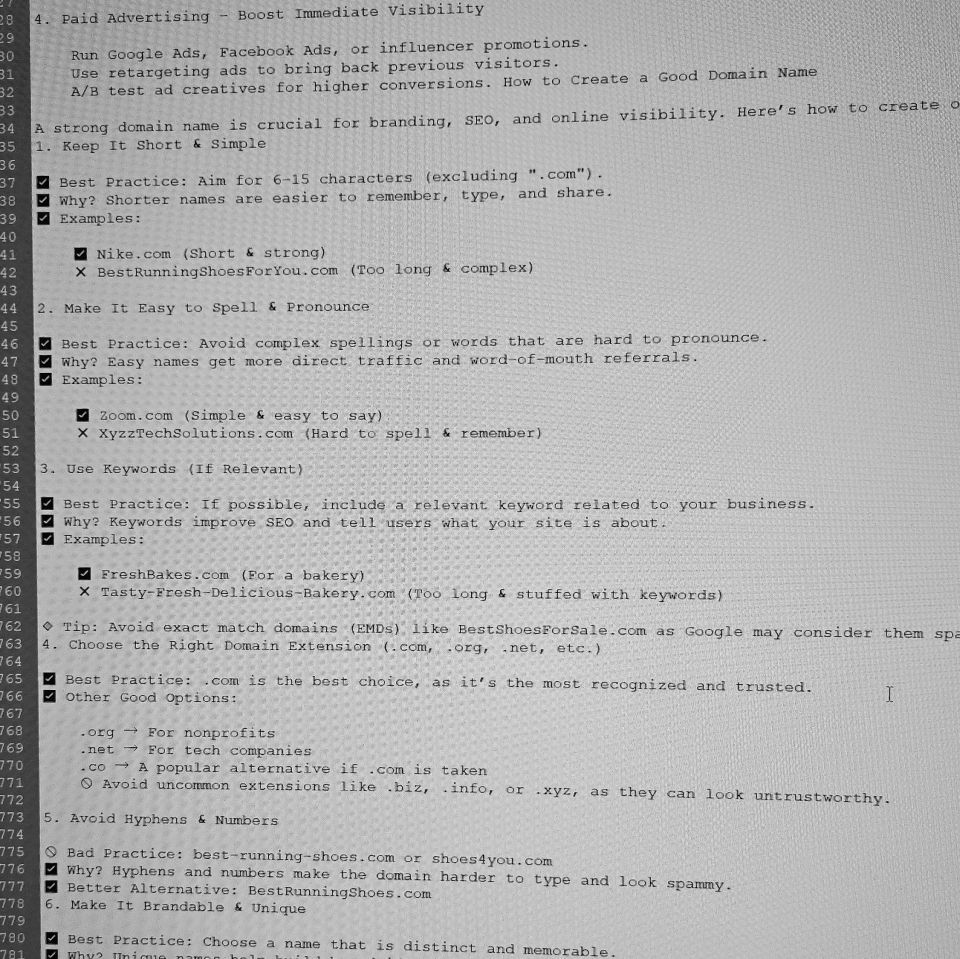
Title Tags & Meta Descriptions – Writing compelling titles & descriptions. ✅ Internal Linking – Connecting pages within your website. ✅ URL Structure – Using clean, keyword-rich URLs. ✅ Image Optimization – Compressing images and using alt text for accessibility. 🔹 Example: If you sell running shoes, your title could be: "Best Running Shoes for Beginners – Comfort & Durability Guide" 2. Off-Page SEO (Building Authority & Trust) This focuses on factors outside your website that impact rankings. ✅ Backlinks – Getting links from other trusted websites (like a vote of confidence). ✅ Social Signals – Shares, likes, and engagement on social media. ✅ Guest Blogging – Writing articles for other sites with links back to yours. 🔹 Example: A fitness blog links to your running shoe store as a recommended brand. 3. Technical SEO (Improving Performance & Usability) This ensures search engines can crawl and index your site properly. ✅
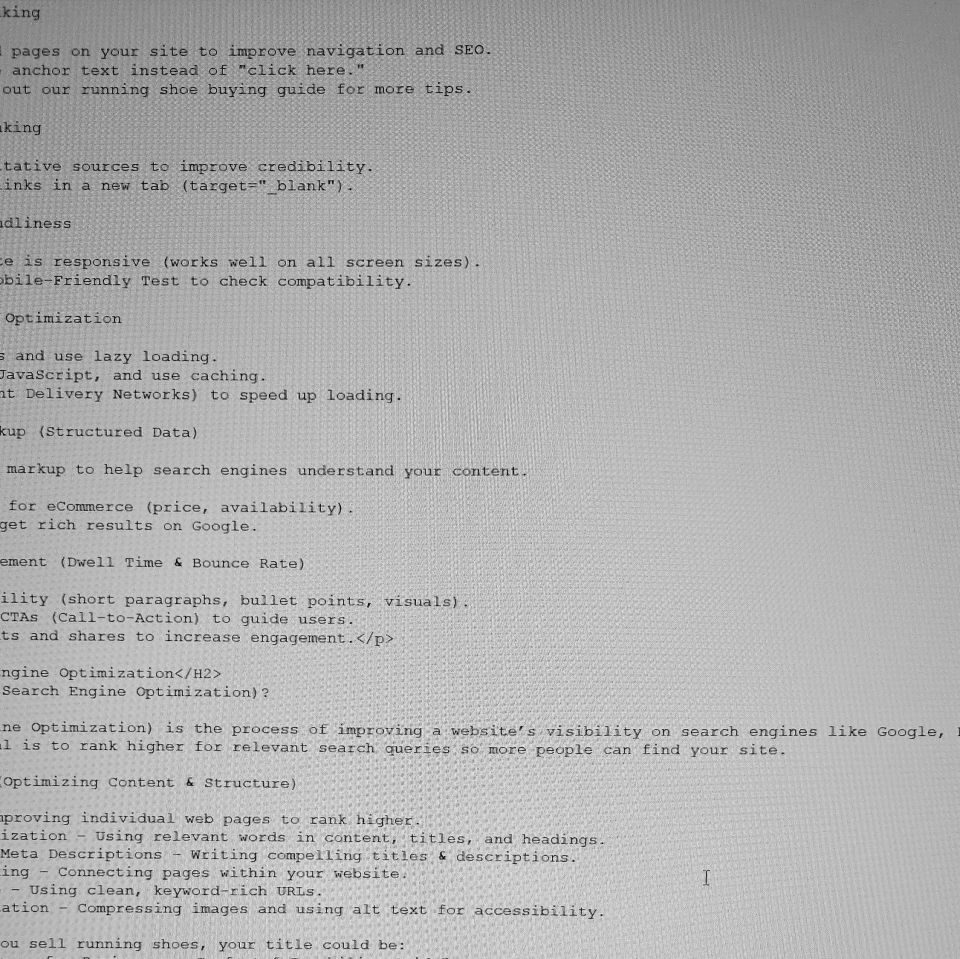
Fast Loading Speed – Compressing images, using caching, and minimizing code. ✅ Mobile-Friendliness – Ensuring the site works well on all devices. ✅ SSL Security (HTTPS) – A secure website ranks better. ✅ Schema Markup – Adding structured data to help search engines understand your content. 🔹 Example: A fast, mobile-friendly website gets higher rankings than a slow one. 4. Local SEO (Optimizing for Local Searches) For businesses that serve specific locations. ✅ Google My Business – Claiming and optimizing your listing. ✅ NAP Consistency – Ensuring Name, Address, and Phone Number are correct. ✅ Customer Reviews – Encouraging positive reviews to boost credibility. 🔹 Example: If someone searches "best coffee shop near me", Google ranks businesses with good local SEO first. How Does SEO Work? 1️⃣ Crawling – Search engines scan your website using bots. 2️⃣ Indexing – They store your pages in a database. 3️⃣ Ranking – Google uses 200+ factors to decide where to rank your page. Main Ranking Factors: ✅ Relevance – Does your page answer the search query? ✅ Authority – Does your site have quality backlinks? ✅ User Experience (UX) – Is your site fast, mobile-friendly, and easy to navigate? Why is SEO Important? 🔹 Increases Organic Traffic – Free, long-term traffic vs. paid ads. 🔹 Builds Credibility & Trust – Higher rankings = more trust. 🔹 Improves User Experience – Faster, well-structured sites perform better. 🔹 Higher Conversion Rates – More visibility = more potential sales or leads.
URL Optimization: Best Practices for SEO URL optimization is a key part of on-page SEO, helping search engines and users understand what your page is about. A well-structured URL improves search rankings, user experience, and click-through rates (CTR). 1. Keep URLs Short and Simple Best Practice: Aim for 3-5 words in a URL. Why? Shorter URLs are easier to read, remember, and share. Example: ✅ example.com/best-running-shoes ❌ example.com/category/footwear/2025-newest-best-running-shoes-for-beginners 2. Use Keywords in URLs Best Practice: Include your primary keyword to improve relevance. Why? Helps search engines understand your content and boosts rankings.
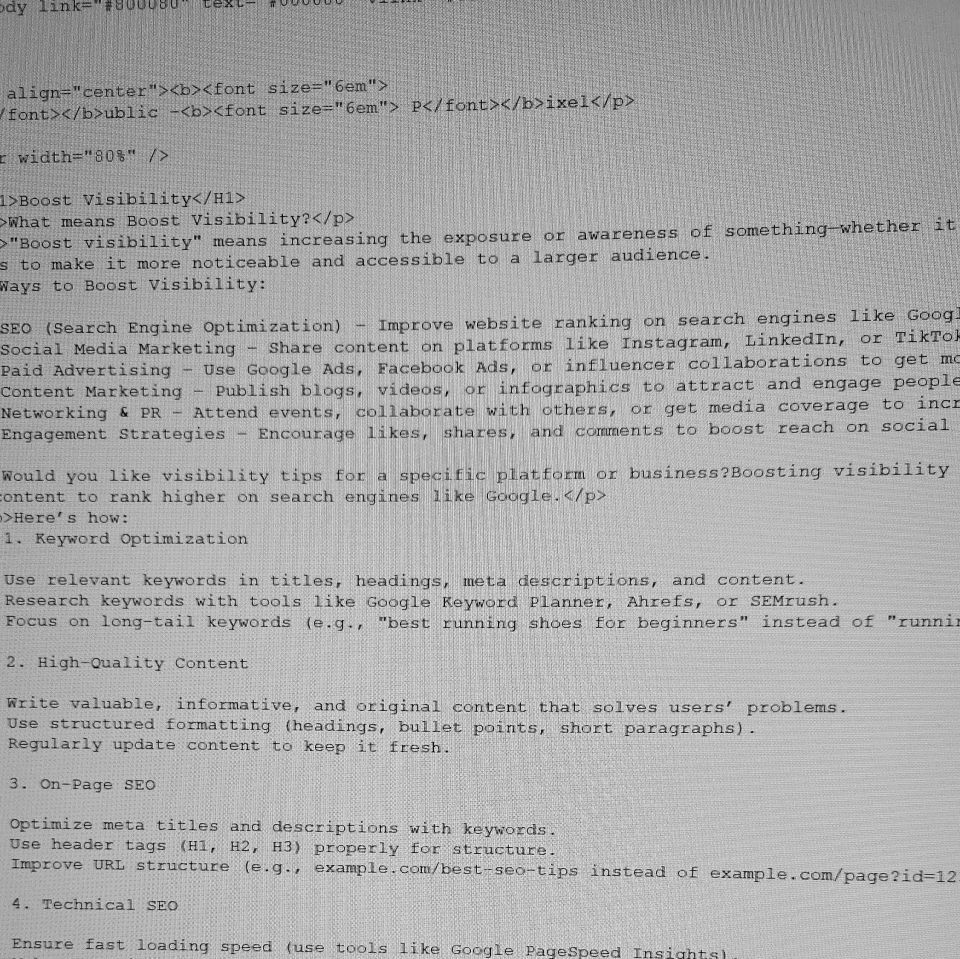
Example: ✅ example.com/healthy-diet-tips ❌ example.com/article123 (Not descriptive) 🔹 Avoid keyword stuffing: ❌ example.com/best-diet-tips-healthy-diet-tips-weight-loss-tips 3. Use Hyphens (-) Instead of Underscores (_) or Spaces Best Practice: Separate words with hyphens (-), not underscores (_) or spaces. Why? Google treats underscores as part of a word, making healthy_diet_tips harder to read. Example: ✅ example.com/seo-best-practices ❌ example.com/seo_best_practices 4. Avoid Stop Words & Unnecessary Words Stop words: "and," "the," "of," "in," "for" (remove unless necessary). Why? Shorter URLs are easier to read and more effective for SEO. Example: ✅ example.com/best-coffee-brands ❌ example.com/the-best-coffee-brands-in-the-world 5. Keep URL Structure Logical & Organized Best Practice: Follow a clear hierarchy for website structure. Why? Helps search engines and users navigate your site easily. 🔹 Example of a well-structured URL: ✅ example.com/blog/seo-tips ✅ example.com/shoes/running/nike-airmax 🔹 Bad URL Structure: ❌ example.com/p=123 (No meaning) ❌ example.com/blogpostxyz-2025-v1 6. Avoid Dynamic Parameters in URLs Best Practice: Use static URLs instead of URLs with unnecessary parameters (?id=123&cat=456). Why? Static URLs are more readable and SEO-friendly. 🔹 Example: ✅ example.com/best-laptops-2025 ❌ example.com/index.php?id=23&product=best-laptops 7. Use HTTPS (Secure URLs) Best Practice: Always use HTTPS instead of HTTP. Why? Google prioritizes secure websites in rankings. Example: ✅ https://example.com (Secure) ❌ http://example.com (Not secure) 8. Match URLs to Page Titles (But Not Exactly) Best Practice: URLs should reflect the page title but remain concise. Example: Title: 10 Best SEO Tips to Boost Your Google Rankings in 2025 URL: ✅ example.com/seo-tips-2025 (Concise & relevant) Avoid: ❌ example.com/10-best-seo-tips-to-boost-google-rankings-in-2025 (Too long) 9. Implement Canonical Tags for Duplicate Content Best Practice: Use a canonical tag (rel="canonical") to prevent duplicate content issues. Why? Helps Google know which version of a page to rank. 🔹 Example: If the same product exists at: ✅ example.com/shoes/nike-airmax ✅ example.com/footwear/nike-airmax You can use a canonical tag to tell search engines which one to prioritize. 10. Use Lowercase Letters in URLs Best Practice: Always use lowercase letters. Why? Some servers treat uppercase and lowercase differently, causing duplicate URLs. Example: ✅ example.com/best-smartphones ❌ example.com/Best-Smartphones (Possible duplicate issues) Final URL Optimization Checklist ✅ ✔ Short & readable (3-5 words max) ✔ Includes target keyword ✔ Uses hyphens (-) instead of underscores (_) or spaces ✔ No unnecessary stop words ✔ Logical structure & hierarchy ✔ Avoids dynamic parameters (?id=123) ✔ Uses HTTPS for security ✔ Reflects page content but stays concise ✔ Canonical tag for duplicate content ✔ Lowercase letters only Conclusion: Why URL Optimization Matters 🔹 Better rankings – Google prefers clear, keyword-rich URLs. 🔹 Improved user experience – Users trust short, readable URLs. 🔹 Higher click-through rates (CTR) – Clean URLs encourage more clicks. 🔹 Easier sharing – Short URLs are easier to share on social media and other platforms.Boosting Visibility Through URL Optimization A well-optimized URL can improve search rankings, increase click-through rates (CTR), and enhance user experience. Here’s how to maximize visibility through URL structure: 1. Use Short & Descriptive URLs Why? Shorter URLs are easier to read, share, and rank better in search engines. Best Practice: Keep URLs under 5 words and avoid unnecessary characters. Example: ✅ example.com/seo-tips (Concise & relevant) ❌ example.com/12345?=xyzseo-tips-2025&utm_source (Too long & confusing) 2. Include Target Keywords Why? URLs with keywords improve SEO and relevance. Best Practice: Use primary keywords naturally. Example: ✅ example.com/best-coffee-brands ❌ example.com/article-4567 (No keyword relevance) 3. Avoid Stop Words & Unnecessary Words Why? Stop words like "and," "the," "of" don’t add SEO value. Best Practice: Remove filler words while keeping readability. Example: ✅ example.com/best-running-shoes ❌ example.com/the-best-running-shoes-for-you 4. Use Hyphens (-) Instead of Underscores (_) or Spaces Why? Google treats hyphens as word separators, while underscores join words together. Best Practice: Always use hyphens (-) for better readability. Example: ✅ example.com/seo-strategies ❌ example.com/seo_strategies 5. Create a Logical URL Structure Why? A well-structured URL improves navigation and indexability. Best Practice: Use a category/subcategory structure when needed. Example: ✅ example.com/blog/seo-basics ❌ example.com/index.php?id=45987&cat=seo (Too complex) 6. Use Lowercase Letters Why? Some servers treat uppercase and lowercase URLs differently, causing duplicate content issues. Best Practice: Stick to lowercase. Example: ✅ example.com/digital-marketing ❌ example.com/Digital-Marketing 7. Secure Your URL with HTTPS Why? Google prioritizes secure websites (HTTPS) over non-secure ones (HTTP). Best Practice: Always use an SSL certificate. Example: ✅ https://example.com (Secure) ❌ http://example.com (Not secure) 8. Avoid Dynamic Parameters & Special Characters Why? URLs with symbols, numbers, or parameters look messy and are harder for search engines to understand. Best Practice: Stick to clean, readable URLs. Example: ✅ example.com/healthy-recipes ❌ example.com/page?id=345&cat=food&type=xyz Final URL Optimization Checklist ✅ ✔ Short & readable (3-5 words max) ✔ Includes primary keyword ✔ Uses hyphens (-) instead of underscores (_) or spaces ✔ Logical URL structure ✔ Avoids stop words & unnecessary characters ✔ Uses HTTPS for security ✔ No dynamic parameters or special characters ✔ Lowercase letters only By following these URL best practices, your pages will be easier to find, rank higher on search engines, and attract more clicks.
Boosting Visibility Through Domain Name Optimization Your domain name plays a crucial role in SEO, branding, and visibility. A well-chosen domain can improve search rankings, user trust, and click-through rates (CTR). 1. Choose a Short & Memorable Domain ✅ Best Practice: Keep your domain name under 15 characters for better recall. ✅ Why? Shorter domains are easier to type, remember, and share. ✅ Example: ✅ Nike.com (Short & brandable) ❌ BestShoesForRunningAndSports.com (Too long & hard to type) 2. Use Keywords in Your Domain (If Relevant) ✅ Best Practice: If possible, include a keyword related to your niche. ✅ Why? Helps with SEO & brand relevance. ✅ Example: ✅ BestCoffee.com (Keyword-focused & easy to remember) ❌ Xyzbusiness123.com (No relevance to industry) 🔹 Note: Avoid exact match domains (EMDs) like BestShoesForSaleOnline.com as Google may flag them as spammy. 3. Choose the Right Domain Extension (.com, .net, .org, etc.) ✅ Best Practice: .com is the most trusted and widely recognized. ✅ Why? Users naturally type .com, making it easier to remember. ✅ Other Good Options: .org → For nonprofits .net → For tech companies .co → Alternative if .com is taken 🚫 Avoid obscure extensions like .biz or .info as they are often linked to spam. 4. Avoid Hyphens & Numbers 🚫 Bad Practice: best-running-shoes.com or shoes4you.com ✅ Why? Hyphens and numbers make the domain harder to type and look spammy. ✅ Better Alternative: BestRunningShoes.com 5. Make It Brandable & Unique ✅ Best Practice: Choose a distinct name that stands out. ✅ Why? Unique domains build trust and improve branding. ✅ Example: ✅ Airbnb.com (Brandable & easy to remember) ❌ ShortTermRentals.com (Too generic) 6. Secure Social Media Handles ✅ Best Practice: Check if the domain name is available on Twitter, Instagram, Facebook, LinkedIn, etc. ✅ Why? Consistent branding across platforms improves visibility. ✅ Example: If your domain is EcoFriendlyShop.com, ensure @EcoFriendlyShop is available on social media. 7. Use HTTPS (SSL Certificate) for Security ✅ Best Practice: Always use HTTPS instead of HTTP. ✅ Why? Google favors secure websites, and it builds trust with users. ✅ Example: ✅ https://BestShoes.com (Secure & SEO-friendly) ❌ http://BestShoes.com (Not secure, lower ranking) Final Domain Optimization Checklist ✅ ✔ Short (under 15 characters) & easy to remember ✔ Includes a keyword (if relevant) ✔ Uses .com (or a relevant extension like .org, .net, .co) ✔ No hyphens or numbers ✔ Brandable & unique ✔ Social media handles available ✔ Uses HTTPS for security By following these domain name best practices, you’ll improve SEO visibility, brand trust, and online presence. .The four main basics for boosting visibility are: 1. SEO (Search Engine Optimization) – Get Found on Google Optimize your website with keywords, meta tags, and quality content. Improve on-page SEO (titles, URLs, internal linking). Build backlinks from reputable sites for authority. Ensure fast loading speed & mobile-friendliness. 2. Content Marketing – Create Value for Your Audience Publish blogs, videos, and infographics that solve problems. Use storytelling to engage users. Keep content fresh, informative, and shareable. 3. Social Media Presence – Expand Your Reach Stay active on Facebook, Instagram, LinkedIn, Twitter, TikTok, etc. Engage with followers through comments, shares, and live sessions. Use hashtags & trending topics to increase exposure. 4. Paid Advertising – Boost Immediate Visibility Run Google Ads, Facebook Ads, or influencer promotions. Use retargeting ads to bring back previous visitors. A/B test ad creatives for higher conversions. How to Create a Good Domain Name A strong domain name is crucial for branding, SEO, and online visibility. Here’s how to create one that is memorable, professional, and SEO-friendly: 1. Keep It Short & Simple ✅ Best Practice: Aim for 6-15 characters (excluding ".com"). ✅ Why? Shorter names are easier to remember, type, and share. ✅ Examples: ✅ Nike.com (Short & strong) ❌ BestRunningShoesForYou.com (Too long & complex) 2. Make It Easy to Spell & Pronounce ✅ Best Practice: Avoid complex spellings or words that are hard to pronounce. ✅ Why? Easy names get more direct traffic and word-of-mouth referrals. ✅ Examples: ✅ Zoom.com (Simple & easy to say) ❌ XyzzTechSolutions.com (Hard to spell & remember) 3. Use Keywords (If Relevant) ✅ Best Practice: If possible, include a relevant keyword related to your business. ✅ Why? Keywords improve SEO and tell users what your site is about. ✅ Examples: ✅ FreshBakes.com (For a bakery) ❌ Tasty-Fresh-Delicious-Bakery.com (Too long & stuffed with keywords) 🔹 Tip: Avoid exact match domains (EMDs) like BestShoesForSale.com as Google may consider them spammy. 4. Choose the Right Domain Extension (.com, .org, .net, etc.) ✅ Best Practice: .com is the best choice, as it’s the most recognized and trusted. ✅ Other Good Options: .org → For nonprofits .net → For tech companies .co → A popular alternative if .com is taken 🚫 Avoid uncommon extensions like .biz, .info, or .xyz, as they can look untrustworthy. 5. Avoid Hyphens & Numbers 🚫 Bad Practice: best-running-shoes.com or shoes4you.com ✅ Why? Hyphens and numbers make the domain harder to type and look spammy. ✅ Better Alternative: BestRunningShoes.com 6. Make It Brandable & Unique ✅ Best Practice: Choose a name that is distinct and memorable. ✅ Why? Unique names help build brand identity and recognition. ✅ Examples: ✅ Airbnb.com (Brandable & unique) ❌ ShortTermRentals.com (Too generic) 🔹 Tip: Check if the social media handles are available to keep branding consistent. 7. Future-Proof Your Domain ✅ Best Practice: Choose a domain that can grow with your business. ✅ Why? A narrow name might limit you in the future. ✅ Examples: ✅ TechWorld.com (Flexible for growth) ❌ BestLaptops2024.com (Might be outdated next year) 8. Secure Your Domain with HTTPS (SSL Certificate) ✅ Best Practice: Always use HTTPS instead of HTTP. ✅ Why? Google favors secure websites, and users trust them more. ✅ Example: ✅ https://BestShoes.com (Secure & SEO-friendly) ❌ http://BestShoes.com (Not secure, lower ranking) Final Domain Name Checklist ✅ ✔ Short (under 15 characters) & easy to spell ✔ No hyphens or numbers ✔ Brandable & unique ✔ Includes a relevant keyword (if possible) ✔ Uses .com (or a relevant extension like .org, .net, .co) ✔ Future-proof (not too niche or time-limited) ✔ Social media handles available ✔ Uses HTTPS for security By following these tips, you'll create a strong, SEO-friendly domain that boosts your brand and visibility.